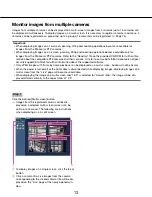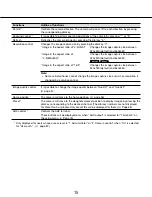
16
16
17
Action at an alarm occurrence
The alarm action (camera action at an alarm occurrence) will be performed when the following alarms occur.
Alarm type
Terminal alarm:
When connecting an alarm device such as a sensor to the EXT I/O connector of the camera, the
alarm action will be performed when the connected alarm device is activated.
VMD alarm:
When motion is detected in the set VMD area, the alarm action will be performed.
* VMD stands for "Video Motion Detection".
Command alarm:
When a Panasonic alarm protocol is received from the connected device via a network, the
alarm action will be performed.
Action at an alarm occurrence
Display the alarm occurrence indication button on the "Live" page (
☞
Page 11)
The alarm occurrence indication button will be displayed on the "Live" page at an alarm occurrence.
Important:
• When "Polling(30s)" is selected for "Alarm status update mode" (
☞
page 32), the Alarm occurrence indication
button will be refreshed in 30-second intervals. For this reason, it may take a maximum of 30 seconds until the
alarm occurrence indication button is displayed on the "Live" page at an alarm occurrence.
Notify of alarm occurrences to the device connected to the alarm connector
It is possible to output signals from the alarm connector on the rear of the camera and sound the buzzer when an
alarm occurs. The settings for the alarm output can be configured in the "Alarm output terminal setup" section of
the [Alarm] tab of the "Alarm" page. (
☞
Pages 75 and 79)
Save images on the SD memory card
When an alarm occurs, images (JPEG/H.264) will be saved on the SD memory card. The settings to save images on
the SD memory card can be configured on the [SD memory card] tab of the "Basic" page (
☞
pages 33 and 34) and
the [Alarm] tab of the [Alarm] page (
☞
page 77).
Transmit an image onto a server automatically
An alarm image can be transmitted at an alarm occurrence to the server designated in advance. The settings
required to transmit an alarm image to a server can be configured in the "Alarm image" section on the [Alarm] tab of
the "Alarm" page (
☞
page 77) and the [FTP] tab (
☞
page 91) of the "Server" page.
Important:
• Select "FTP error" for "Save trigger" on the [SD memory card] tab when using the SD memory card. When
"Alarm input" or "Manual" is selected for "Save trigger", an alarm image will not be transmitted at an alarm
occurrence to the FTP server.
Notify of alarm occurrences by e-mail
Alarm mail (alarm occurrence notification) can be sent at an alarm occurrence to the e-mail addresses registered in
advance. Up to 4 addresses can be registered as recipients of the alarm mail. An alarm image (still picture) can be
sent with the alarm mail as an attached file. The settings for alarm mail can be configured in the "Mail notification"
section on the [Notification] tab of the "Alarm" page (
☞
page 83) and the [Mail] tab of the "Server" page (
☞
page
90).
Notify of alarm occurrences to the designated IP addresses (Panasonic alarm protocol notification)
This function is available only when a Panasonic device, such as the network disk recorder, is connected to the
system. When "On" is selected for "Panasonic alarm protocol", the connected Panasonic device will be notified
that the camera is in the alarm state. The settings for Panasonic alarm protocol can be configured in the Panasonic
alarm protocol section of the [Notification] tab of the "Alarm" page. (
☞
Page 84)
















































